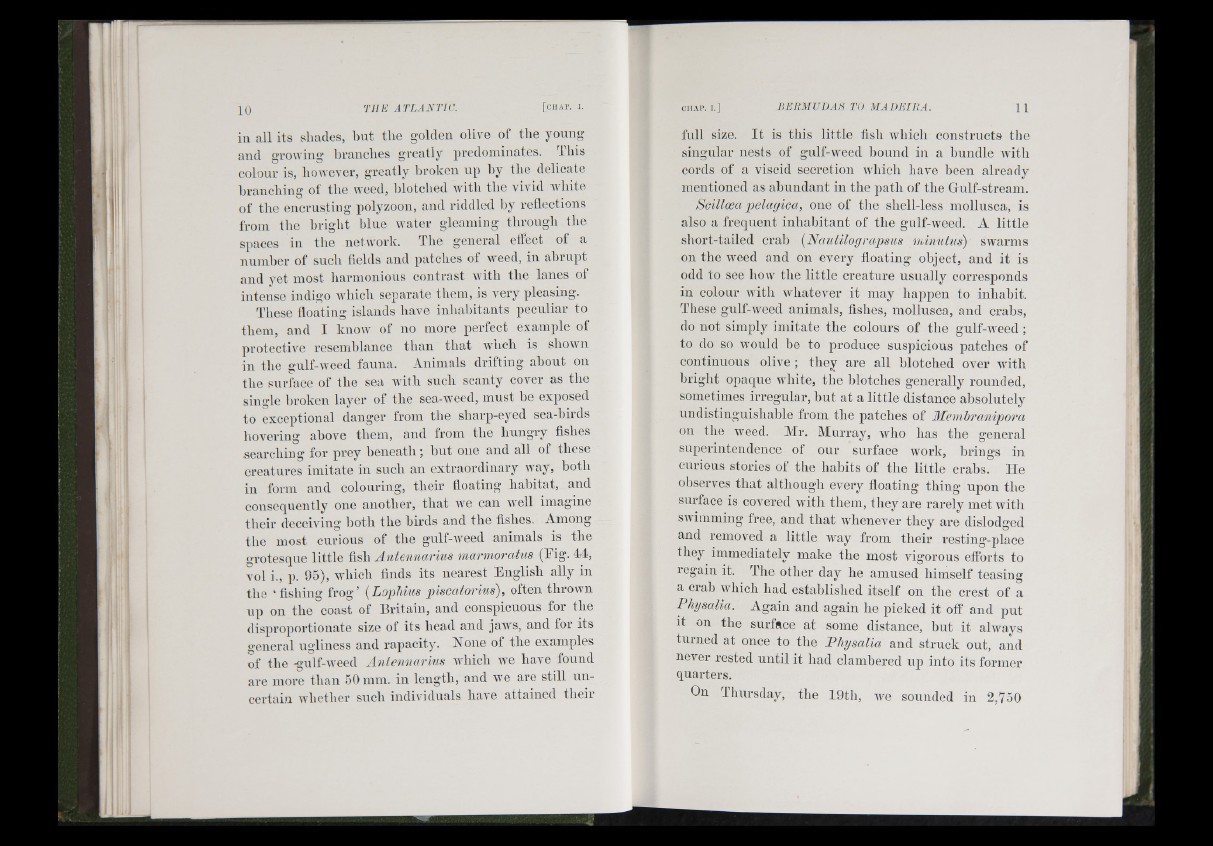
1 0
in all its shades, h n t th e golden olive of th e yonng
and growing b ranches gre a tly predominates. This
colour is, however, gre a tly brok en n p hy th e delicate
b ra n c h in g of th e weed, blotched Avith th e viAnd AA'hite
of th e cn c rn s tin g polyzoon, and riddled, hy reflections
from th e b r ig h t hlne Avater g le aming th ro u g h th e
spaces in th e iietAVork. The g eneral effect of a
n nmb e r of snch fields and patches of weed, in a h rn p t
and yet mos t ha rmon io n s co n tra s t Avith th e lanes ol
intense indigo Avhich separate th em, is very pleasing.
These floating islands have in h a b ita n ts pe cu lia r to
th em, an d I knoAv of no more perfect example of
protective resemblance th a n th a t Avlich is shoAvn
in th e gnlf-weed fanna. Animals d rif tin g ah on t on
th e surface of th e sea Avith snch scanty cover as th e
single broken layer of th e sea-Aveed, m n s t be exposed
to exceptional d anger from th e sharp-eyed sea-hirds
hove ring above th em, an d from th e lin ng ry fishes
searching for prey b e n e a th ; h u t one an d all of these
cre atures imita te in such an ex tra o rd in a ry Avay, b o th
ill form a n d colouring, th e ir floating h a b ita t, and
consequently one an o th e r , th a t Ave can Avell imagine
th e i r deceiAung b o th th e birds and th e fishes. Amo n g
tlie mos t curious of th e gulf-Aveed anima ls is th e
grotesque l ittle fish A n te n n a rm s marmoratus (Eig. 44,
vol i., p. 95), Avhich finds its ne ares t E n g lish ally in
th e ‘ fishing f r o g ’ {LopUus piscatorkis ), often throAvn
n p on th e coast of Brita in , an d conspicuous for the
disproportionate size of its head and jaws, and for its
general uglines s and rapa city. None of th e examples
of th e -gulf-Aveed A n ten n a r iu s AAdiich Ave have found
are more th a n 50 mm. in len g th , and Ave are still iin-
c ertain Avhether such individuals have a tta in ed th e ir
full size. It is this little fish Avhich constructs the
singular nests of gnlf-weed hound in a bundle AAntli
cords of a viscid secretion aaI iícIi have been already
mentioned as abundant in the path of the Gulf-stream.
Scillcea pelágica, one of the shell-less mollusca, is
also a frequent in h abitant of the gulf-Aveed. A little
short-tailed crab [Naidilograpsiis mimitiis) SAvarms
on the Aveed and on every floating object, and it is
odd to see how the little creature usually corresponds
in colour Avith Avhatever it may happen to inhabit.
These gulf-AA^eed animals, fishes, mollusca, and crabs,
do not simply imitate the colours of the gulf-Aveed ;
to do so Avould be to produce suspicious patches of
continuous olive ; they are all blotched over Avith
bright opaque vA-hite, the blotches generally rounded,
sometimes irregular, but at a little distance absolutely
undistinguishahle from the patches of Ilemhranipora
on the Aveed. Mr. Murray, avIio has the general
superintendence of our surface work, brings in,
curious stories of the habits of the little crabs. He
observes th a t although every floating th ing upon the
surface is covered Avith them, they are rarely met AAuth
SAvimming free, and th a t Avlienever they are dislodged
and removed a little AA^ay from their resting-place
they immediately make the most vigorous efforts to
regain it. The other day he amused himself teasing
a crab Avhich had established itself on the crest of a
Physcdia. Again and again he picked it off and put
it on the surface at some distance, h u t it ahvays
turned at once to the Physalia and struck out, and
never rested u n til it had clambered up into its former
quarters.
On Thursday, the 19th, aa^c sounded in 2,750